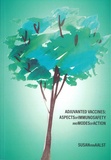Adjuvanted vaccines
Aspects of immunosafety and modes of action
Summary
New developments in vaccine design shift towards safe, though sometimes less immunogenic, subunit and synthetic antigens. Therefore, the majority of current vaccines require adjuvants to increase immunogenicity. Most adjuvants available were developed empirically and their mode of action is only partly elucidated. Earlier work shows that adjuvants exert their effect mainly on the innate immune system. To improve vaccines, more knowledge on adjuvants’ modes of action and their effect on innate immune responses at the site of application are required. Furthermore, immune responses that take place after vaccination are sometimes linked with the development or exacerbation of autoimmune diseases (AID). It is highly debated íf vaccines indeed induce or aggravate AID and in particular adjuvants are mentioned as potential cause. Since vaccines are given on a large scale, more research is warranted. The aim of this thesis was to study working mechanisms of vaccines and adjuvants locally (innate immune system) as well as systemically (adaptive immune system) to identify possible risks on severe side effects of vaccination and potentially improve vaccine effectiveness.
A panel of human and experimental adjuvants was tested in mice for their local effects and ability to initiate adaptive responses. Rapid but transient immune-stimulatory environments were induced by most adjuvants. Antigen-uptake and -presentation by APC and maturation of APC were differentially affected by distinct adjuvants. The choice of adjuvant determined the outcome of the initiated adaptive immune response and we showed that the route of administration of vaccines (intranasal or intradermal) also influences the response induced.
Two potential mechanisms on how AID could result from vaccination were explored; (1) bystander activation and (2) disturbances in regulatory T cells (Treg). During bystander activation, T cells unrelated to the antigen presented can be activated without (strong) T cell receptor (TCR) ligation, but via signals derived from the ongoing response directed against the vaccine-antigen or adjuvant at hand. Our study demonstrated that for a model vaccine (comprising the unsafe adjuvant Complete Freund’s adjuvant) not the adjuvant, but the vaccine-antigen likely induced limited bystander responses. No evidence was obtained that adjuvation of antigen specific responses is essential for bystander activation.
Regulatory T cells (Treg) function in the prevention of excessive inflammation and maintenance of immunological homeostasis. However, these cells may also interfere with resolution of infections or with immune reactions following vaccination. Effects of Treg on vaccine responses are nowadays investigated, but the impact of vaccination on Treg homeostasis is still largely unknown. This may be a relevant safety aspect, since loss of tolerance through reduced Treg may trigger autoimmunity. Both in men and mice, safe vaccines were shown to have only minimal impact on Treg frequencies and characteristics and even an unsafe stimulus (CFA) did not result in significant (long term) effects on Treg of mice.
More knowledge on adjuvants, both their modes of action and aspects of immunosafety, will aid in the development of new, improved and safe(r) vaccines that will provide good protection against infectious diseases without any unnecessary side effects.
